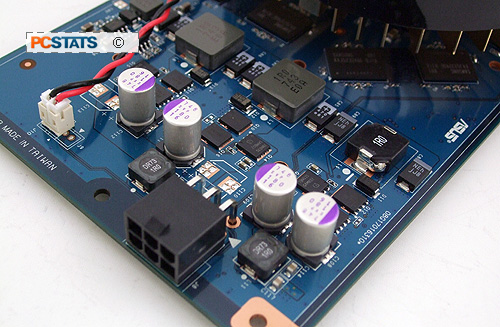
|
Once the darling of the budget constrained computer gamer, nVidia's Geforce 9600GT has been pushed aside by AMD's mainstream HD4850 and the sudden swell in Crossfire supporting 4-series Intel motherboards.
78% Rating: 
|
|
|
|
Home >
Reviews >
Video Cards >
ASUS EN9600GT Top/HTDI/512M |
|
|
Power Consumption of Videocards
The computer industry is slowly but
surely moving towards more energy efficient products and better manufacturing
processes. As consumers the best we can hope for are products which lightly sip electricity, resulting in
lower electrical costs and generally less heat and quieter operation. High
end graphics cards use a lot of power, so this is why PCSTATS
is including figures on total power consumption in
our reviews now. 
Clearly, to be seen as conserving energy
is the PC industries newest marketable trend.
Naturally evolving die-shrinks have helped reduce the
power demands of graphics cards, but ATI and nVidia really need to do more to reign
in their flagship GPUs. In many high end gaming
computers, the graphics cards alone draws more power than the
CPU, sometimes even the entire PC system!
nVidia's G94 GPU is manufactured on TSMC's 65nm technology, so
it's naturally a little more power efficient than the 90nm generation that came
before it.
For clearer view on the power demands of the Asus EN9600GT, PCSTATS will measure the total system power draw
with a power meter and comparing this against the same basic installation
with a couple different videocards. A short list of nVidia and ATI videocards that
span the mainstream to high end market segments are listed below; total system
power draw, Watts, is noted for the stressed and idle states of the
graphics card.
 Videocard Power Consumption (Total System
Power Draw) Videocard Power Consumption (Total System
Power Draw) |
| Idle at Desktop |
Watts* |
Ranking |
| Asus EAH3870 X2 1GB
TOP/G/3DHTI/1G/A |
153 |
   |
| Diamond Viper Radeon HD 2900XT in
CrossFire |
195 |
   |
| Asus EAH4850 HTDI/512M |
120 |
   |
| Asus EAX1900XTX 2DHTV/512M/A |
160 |
   |
| Asus EAX1950PRO/HTDP/256M/A |
150 |
   |
| nVidia Geforce 9600GTs in SLI |
166 |
   |
 Asus EN9600GT Top/HTDI/512M Asus EN9600GT Top/HTDI/512M |
152 |
   |
| Palit Geforce 9600GT 512 |
151 |
   |
| MSI NX8800GTX-T2D768E |
196 |
   |
| MSI NX7950GX2-T2D1GE |
183 |
   |
| MSI NX7900GTX-T2D512E |
165 |
   |
| Gigabyte GV-NX76T256D-RH |
140 |
   |
| 3D Loaded: |
Watts* |
Ranking |
| Asus EAH3870 X2 1GB
TOP/G/3DHTI/1G/A |
390 |
   |
| Diamond Viper Radeon HD 2900XT in
CrossFire |
549 |
   |
| Asus EAH4850 HTDI/512M |
202 |
   |
| Asus EAX1900XTX 2DHTV/512M/A |
333 |
   |
| Asus EAX1950PRO/HTDP/256M/A |
252 |
   |
| nVidia Geforce 9600GT SLI |
313 |
   |
 Asus EN9600GT Top/HTDI/512M Asus EN9600GT Top/HTDI/512M |
220 |
   |
| Palit Geforce 9600GT 512 |
221 |
   |
| MSI NX8800GTX-T2D768E |
345 |
   |
| MSI NX7950GX2-T2D1GE |
315 |
   |
| MSI NX7900GTX-T2D512E |
277 |
   |
| Gigabyte GV-NX76T256D-RH |
213 |
   | |
[*figure represents total system power consumption in Watts, either with
the system at idle, or the peak value recorded while running 3DMark06.
]
The Asus EN9600GT Top/HTDI/512M
videocard unsurprisingly ranks in towards the lower end of this list; it's
total system power draw is a moderate 220W under load (roughly a 68W increase over the
idle state). For comparison, the system equipped with the Radeon HD
4850 hovers around 202Watts while stressed in
3Dmark06.
One thing is clear, neither ATi or nVIDIA is a saint when it comes to
the power consumption of modern graphics cards, but at least each successive
generation is decreasing it's power requirements while improving gaming
performance!
|
